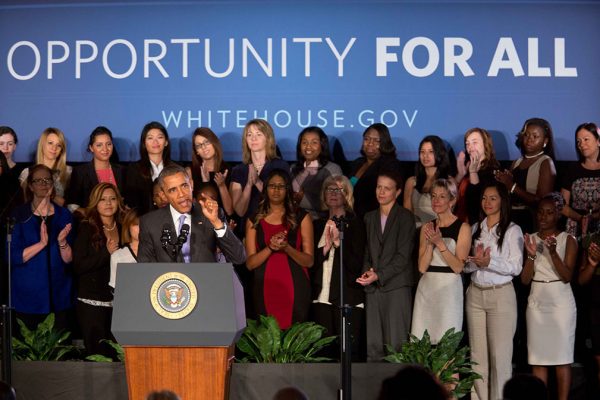We agree with Jacob Hacker and Paul Pierson that there has been a leftward shift in the economic policy priorities of the Democratic Party. But their account of why it has happened is woefully inadequate.
The best evidence of a leftward shift can be found in a bill Hacker and Pierson ignore: the $1.9 trillion American Rescue Plan Act, passed in March 2021 with zero Republican votes. Despite deficit scolds like Larry Summers sounding the alarm, Biden and his team decided to pump an enormous amount of purchasing power into the economy, calculating that inflation risks were less of a political or economic threat than the risk that insufficient demand would lead to prolonged unemployment. This commitment to “running the economy hot”—matched by Biden’s unprecedented support for organized labor (including his installation of the most pro-labor National Labor Relations Board in decades and his open championing of striking autoworkers)—represents a profound break from the austerity-driven agenda of Democrats since the ascendancy of Robert Rubin.
It’s not clear that this break is uniformly at odds with the Democrats’ suburban affluent base. In fact, several of the biggest planks in the American Families Plan would have benefited not only poor and working-class voters but also relatively affluent voters, especially working parents. Persuaded by the arguments of political scientists—Hacker and Pierson among them—that narrowly means-tested programs do not create the constituencies necessary to sustain themselves, Democrats have pushed for programs like paid family and medical leave, universal pre-K, and a significantly expanded child tax credit. All these programs would have provided significant financial support to families with incomes extending to several hundred thousand dollars per year (while at the same time not raising their taxes, as Hacker and Pierson note).
There may thus be less of a puzzle about how the leftward shift could happen than Hacker and Pierson claim. Policies of this sort perfectly match the interests of the Democrats’ U-shaped base, and they are underwritten by a now-ascendant economic theory: what Treasury Secretary Janet Yellen has called “modern supply side economics.” As Yellen sees it, the U.S. economy has been held back by the country’s woefully inadequate child care system, which continues to push women out of the workforce during peak working years. Modernizing social provision to allow for women’s equal participation in the labor market is a “contribution to economic growth . . . as essential as infrastructure or energy.”
As for what caused the Democrats’ leftward shift on economics, Hacker and Pierson leave out a lot. They suggest a proximal motive in the “density tax” that makes it more difficult for Democrats than Republicans to translate votes into seats. On this account, Democrats saw that they were losing working-class voters and responded by pursuing “a certain kind of pocketbook politics” intended to win them back. The politics they came up with was shaped by “the growing electoral clout of the left, the increasing ambitions of party-affiliated organizations, a leftward turn of the party’s economic experts, and the enormous economic and social shock of COVID-19.”
We don’t dispute that these factors played a role. But the root causes, we think, are far more structural, reaching deep into reasons of state. Following political economist Mark Blyth, we believe that major shifts in policy orientation begin with a crisis diagnosis. And in various reports and speeches—though perhaps not in the tweets that Hacker and Pierson focus on—Democratic elites have made their crisis diagnosis clear: they are responding to a perceived triple threat. The first lies in geopolitics—especially with regard to China, which Hacker and Pierson somehow manage not to mention at all. The second comes from the accelerating climate crisis. And third is a domestic crisis that is itself equal parts economic and political.
As Democratic Party leaders see it, China’s rise to the status of a “peer competitor” threatens U.S. economic and security interests. Regularly citing the work of economist David Autor and coauthors on the so-called “China Shock,” they blame China’s growth and trade policies for U.S. manufacturing job losses and subsequent electoral losses to the GOP in many former Democratic strongholds. They note that China dominates the supply chains and manufacturing technologies that are necessary for a clean energy transition. And they fear a future in which China’s economy overtakes America’s.
Climate change, for its part, presents direct threats to health, socio-technical systems, and political stability; Democratic leaders have also decried its threats to national security and U.S. global standing. (Reluctance to act constructively in recent years has damaged U.S. soft power.)
Finally, Democratic elites have blamed the painful fallout of the 2008 financial crisis—along with the disappointing performance of U.S. capitalism in the 2010s—for the rise of both the Trumpist right and the Sandernista left. They have been eager to defuse these “populist” challenges by taking bolder action against secular stagnation. Crucial to this pivot has been a form of self-critique. Democratic staffers in the Obama administration—who now hold leading roles under Biden—came to realize that Obama’s moderation did far deeper socioeconomic and political damage than they expected.
This constellation of threats helps explain the choices that Biden and congressional Democrats made in 2022. Squeezed by the Manchin-Sinema vise, they sacrificed practically everything besides climate in their reconciliation bill because it offered a goldilocks solution to their true concern: the triple crisis of China–climate–secular stagnation. The bill spends a lot of money on green technologies to take on Chinese dominance; builds a clean energy manufacturing ecosystem by providing investor and direct-to-consumer subsidies for EVs, power, and appliances; and promotes broad-based growth by directing investments into union shops, left-behind places, and communities.
Less easily read off recent Democratic reports and speeches is the fact that this crisis threatens not just U.S. interests as the party’s elite understands them, but those elites themselves. Between 2015 and 2021, this group of people really feared that the train of American democracy was about to go off the rails, and if it did, the country would suffer grave consequences—but so would they, as that ineffable but profoundly important thing we call “legitimate authority” very nearly slipped away.
The upshot is that Bidenomics must be understood as a program of “stabilization” rather than a bold progressive agenda, not unlike what historian Charles Maier has identified in his study of European politics in the wake of World War I. It represents a liberalism sufficiently threatened to jettison a great number of shibboleths and undertake genuinely creative departures. But as any such program must be, it is also shot through with contradictions. The train may yet go off the rails.
Boston Review is nonprofit and relies on reader funding. To support work like this, please donate here.








